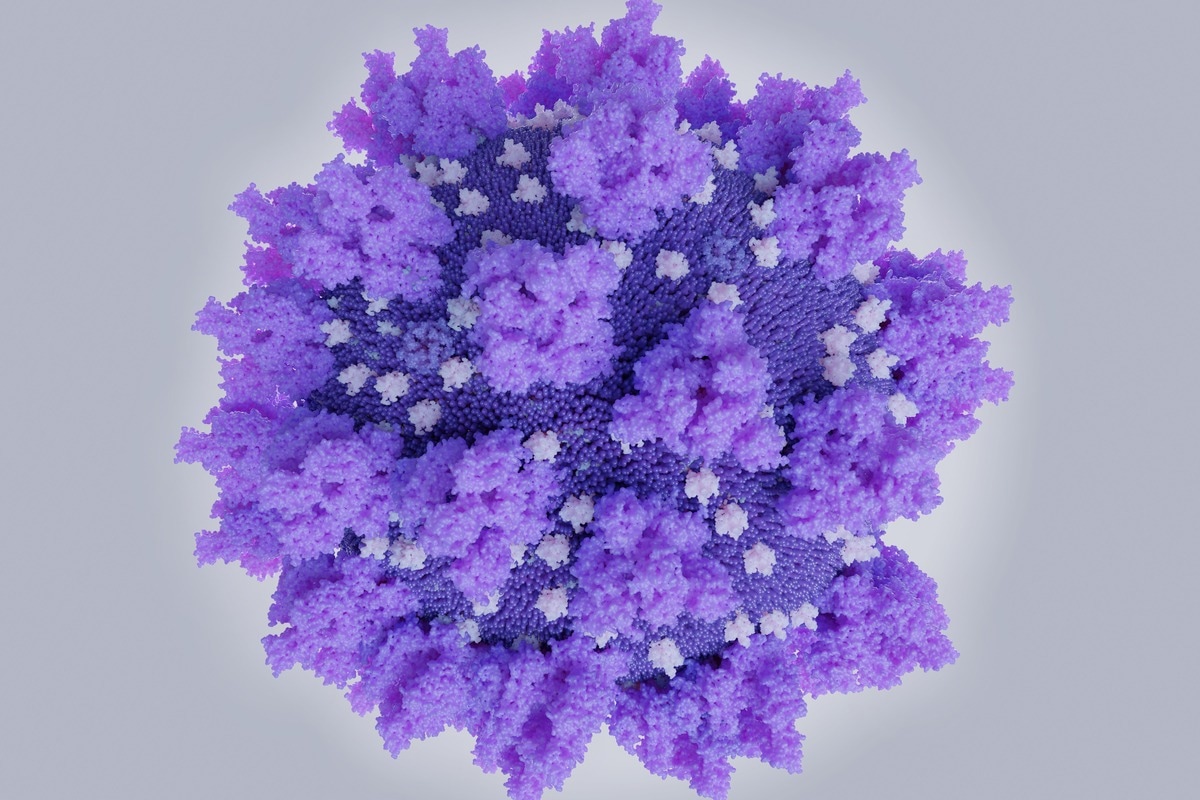In a recent study published in PLOS Pathogens, researchers investigated a highly variable region at residues 203 to 205 in the severe acute respiratory syndrome coronavirus 2 (SARS-CoV-2) nucleocapsid (N) protein.
 Study: Nucleocapsid mutations in SARS-CoV-2 augment replication and pathogenesis. Image Credit: Juan Gaertner/Shutterstock.com
Study: Nucleocapsid mutations in SARS-CoV-2 augment replication and pathogenesis. Image Credit: Juan Gaertner/Shutterstock.com
SARS-CoV-2 has continued to adapt to human infection since its emergence resulting in variants with unique genomic profiles. Most studies of genetic variations have focussed on the SARS-CoV-2 spike (S) protein, the target of existing COVID-19 vaccines. Therefore, the variations in the SARS-CoV-2 structure beyond SARS-CoV-2 S have not been extensively investigated.
About the study
In the present study, researchers explored the site of residues 203 to 205 in SARS-CoV-2 N.
Data of the SARS-CoV-2 genome was obtained from the global initiative on sharing all influenza data (GISAID) database. Subsequently, every sequence was binned based on the collection month, following which in silico analysis was performed for variations at the site of SARS-CoV-2 N, where residues 203 to 205 were situated.
The in silico analysis demonstrated three mutations viz. the R203K+G204R mutation (KR) observed in the SARS-CoV-2 Alpha variant, the Gamma variant, and the Omicron variant; the T205I mutation present in the Beta, Eta, and Mu variants and; the R203M mutation present in the kappa and Delta variants.
To determine whether mutations in the variable region at residues 203 to 205 could increase SARS-CoV-2 infectivity, the kinetics of SARS-CoV-2 variant replication were evaluated using cell culture experiments. Calu-3 2b4 cells (cellosaurus cell line) and Vero E6 cells were inoculated with the ancestral Washington-1 (WA-1) strain or SARS-CoV-2 variants, and subsequently, SARS-CoV-2 replication was assessed at 24- and 48-hours post-infection (hpi).
To evaluate KR mutation effects in isolation, the team recreated the KR mutation in the background of WA-1 using reverse genetics. Post recovery of the recombinant virus, the effects of the KR mutation on replication of SARS-CoV-2 were assessed. Calu-3 2b4 cells and Vero E6 cells were infected with SARS-CoV-2 WA-1 with the mNeonGreen (mNG) reporter or KR mutation, and SARS-CoV-2 titers were evaluated at 24- and 48 hpi.
Next, the team examined the impact of mutations at residues 203 to 205 in other variants of SARS-CoV-2 N on viral replication, for which, using reverse genetics, the R203M mutation was recreated in the background of WA-1. Subsequently, the replication of SARS-CoV-2 in Calu-3 2b4 cells AND Vero E6 cells were evaluated.
The team investigated whether the KR mutation increased the fitness of SARS-CoV-2 by competition assays. The KR mutant (KR mt) and WA-1 competed with each other in infected Calu-3 2b4 cells and Vero E6 cells. At 24 hpi, ribonucleic acid (RNA) levels were observed, and the ratio of WA-1 to the variant genomes was determined using next-generation sequencing (NGS).
The effects of the KR mutation were assessed in vivo by using Syrian hamsters. To evaluate changes in SARS-CoV-2 RNA levels, quantitative reverse transcription-polymerase chain reaction (RT-qPCR) analysis was performed to measure SARS-CoV-2 levels in the Calu-3 2b4 cells infected with KR mt. Further, the in vivo SARS-CoV-2 N antigen staining in the pulmonary tissues of infected hamsters was assessed. The effects of KR mutation on phosphorylation of virion-associated N and glycogen synthase 3 (GSK-3) kinase inhibition were evaluated.
Results
The cell culture experiments showed that in Vero E6 cells, the end-point replication titers of the Alpha variant and the Beta variant were slightly lower than those of WA-1. In contrast, the titers of Kappa were 15 times lower than WA-1. In Calu-3 2b4 cells, the replication titers of Alpha were 5.6 times greater than those of WA-1, whereas the titers of Beta were 2.7 times lower than WA-1 and the Kappa demonstrated no substantial differences compared to WA-1. The findings indicated that N mutations could modulate SARS-CoV-2 infectivity.
The reverse genetics analysis showed, that in Vero E6 cells, the KR mutation led to lower replication titers at 24 hpi; however, the end-point titers were equivalent to WA-1. In Calu-3 2b4 cells, the KR mutation increased endpoint titers in comparison to WA-1. These findings indicated that the KR mutation in SARS-CoV-2 N alone was adequate for enhancing the replication of SARS-CoV-2.
Similarly, in Vero E6 cells, replication of the R203M mutant was lesser than WA-1 at 24 hpi but the endpoint titers were similar to that of WA-1. In Calu-3 2b4 cells, the R203M mutation increased replication titers compared to both the time points. The findings indicate that similar to the KR mutation, the R203M mutation alone was also adequate to increase the replication of SARS-CoV-2.
In the fitness analysis, WA-1 outcompeted the KR mutant with a 4:1 ratio in Vero E6 cells, whereas the KR mutant outcompeted WA-1 with a 10:1 ratio in Calu-3 2b4 cells. In the RT-qPCR analysis, the KR mutation increased SARS-CoV-2 RNA levels by >32-fold. The KR mutation increased SARS-CoV-2 transmission and increased SARS-CoV-2 N antigen staining compared to WA-1 in the lungs of infected hamsters despite no effect on the pulmonary titers.
The KR mutation increased SARS-CoV-2 N phosphorylation for the Alpha, Omicron, and kappa variants compared to the ancestral strain and conferred resistance against inhibition by GSK-3 kinase, providing the molecular basis for enhanced SARS-CoV-2 replication. In addition, an analogous alanine double substitution (AA mt) at positions 203 and 204 mimicked the R203K+G204R mutation, increased SARS-CoV-2 replication, and augmented phosphorylation. This indicated that SARS-CoV-2 infectivity was enhanced in respiratory cells by ancestral RG motif disruption.
Overall, the study findings showed that variant mutations beyond SARS-CoV-2 S are essential components for the continued adaptation of SARS-CoV-2 to human infections. The R203K+G204R mutation in SARS-CoV-2 N alone was adequate to increase SARS-CoV-2 replication, pathogenicity, and fitness by disrupting the ancestral RG motif.
Journal reference:
- Johnson, B. et al. (2022) "Nucleocapsid mutations in SARS-CoV-2 augment replication and pathogenesis", PLOS Pathogens, 18(6), p. e1010627. doi: 10.1371/journal.ppat.1010627.